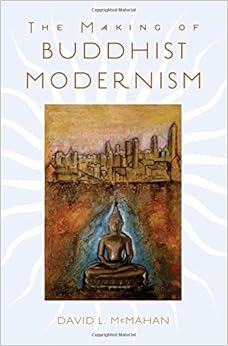
Free Downloads The Making Of Buddhist Modernism

A great deal of Buddhist literature and scholarly writing about Buddhism of the past 150 years reflects, and indeed constructs, a historically unique modern Buddhism, even while purporting to represent ancient tradition, timeless teaching, or the "essentials" of Buddhism. This literature, Asian as well as Western, weaves together the strands of different traditions to create a novel hybrid that brings Buddhism into alignment with many of the ideologies and sensibilities of the post-Enlightenment West. In this book, David McMahan charts the development of this "Buddhist modernism." McMahan examines and analyzes a wide range of popular and scholarly writings produced by Buddhists around the globe. He focuses on ideological and imaginative encounters between Buddhism and modernity, for example in the realms of science, mythology, literature, art, psychology, and religious pluralism. He shows how certain themes cut across cultural and geographical contexts, and how this form of Buddhism has been created by multiple agents in a variety of times and places. His position is critical but empathetic: while he presents Buddhist modernism as a construction of numerous parties with varying interests, he does not reduce it to a mistake, a misrepresentation, or fabrication. Rather, he presents it as a complex historical process constituted by a variety of responses -- sometimes trivial, often profound -- to some of the most important concerns of the modern era.

Hardcover: 320 pages
Publisher: Oxford University Press; 1 edition (November 14, 2008)
Language: English
ISBN-10: 0195183274
ISBN-13: 978-0195183276
Product Dimensions: 9.3 x 1.1 x 6.2 inches
Shipping Weight: 1.3 pounds (View shipping rates and policies)
Average Customer Review: 4.5 out of 5 stars See all reviews (15 customer reviews)
Best Sellers Rank: #109,905 in Books (See Top 100 in Books) #28 in Books > Politics & Social Sciences > Philosophy > Eastern > Buddhism > History #29 in Books > History > World > Religious > Buddhism #156 in Books > Religion & Spirituality > Religious Studies > Sociology

Meditation, compassion, tolerance; spirituality, freedom, rationality: why do these adjectives characterize modern Buddhism? Why not temple worship, ancestral cult, or monastic ritual? How do the Dalai Lama, Thich Nhat Hanh, or Chögyam Trungpa incorporate "strategic occidentalism" into open-minded versions of Buddhism compatible with scientific rationalism, feminism, democracy, ethics, agnosticism, and liberal Christianity? How do Tibetan, Zen, and vipassana "insight" schools of practice adapt for Westernizing markets, whether in Asia, America, or Europe? McMahan mixes theory with examples to explain how both West and East interpret dharma for modern audiences--schooled in abstract thought, raised with consumer capitalism, and participants in globalizing media.Using Donald S. Lopez' definition of a modern form that "stresses equality over hierarchy, the universal over the local, and often exalts the individual above the community," McMahan begins his study (qtd. 8). By demythologizing, detraditionalizing, and psychologizing, the twentieth century continued the efforts of Romantics and rationalists to prove that not only might Buddhism be compatible with post-Enlightenment thought, it might better Christian or scientific models.Chapter Two, "The Spectrum of Tradition and Modernism," takes the case study of the "Shukden affair" to show how tensions brought in-- via psychological definitions-- to the Tibetan controversy have been heightened as the "self-understanding" of those involved has been transformed by this modern version of dharma. Pico Iyer's recent "The Open Road" (also reviewed by me) discusses this awkward P.R. situation for the Dalai Lama at more length.Scholarship enters most doggedly into the middle chapters.
The Making of Buddhist Modernism Chinese Buddhist Monasteries: Their Plan and Its Function as a Setting for Buddhist Monastic Life Making Modernism Soviet: The Russian Avant-Garde in the Early Soviet Era, 1918-1928 Hippie Modernism: The Struggle for Utopia Paul Evans: Crossing Boundaries and Crafting Modernism Logo Modernism (English, French and German Edition) Varieties of Modernism (Art of the Twentieth Century) Giorgio de Chirico and the Metaphysical City: Nietzsche, Modernism, Paris Modernism: A Very Short Introduction Insulating Modernism Edge of Irony: Modernism in the Shadow of the Habsburg Empire Africa in Stereo: Modernism, Music, and Pan-African Solidarity Impossible Modernism: T. S. Eliot, Walter Benjamin, and the Critique of Historical Reason The Wallflower Avant-Garde: Modernism, Sexuality, and Queer Ekphrasis The Société Anonyme: Modernism for America (Yale University Art Gallery) American Puppet Modernism: Essays on the Material World in Performance (Palgrave Studies in Theatre and Performance History) Modern Bodies: Dance and American Modernism from Martha Graham to Alvin Ailey Jewelry Making & Etsy Business Box Set: Jewelry Making Instructions and Useful Tips to Guide You Through How to Start Your Etsy Business (Jewelry Making ... Selling Etsy, Esty Selling Success) Buddhist Monks and Monasteries of India: Their History and Their Contribution to Indian Culture Buddhist Art: An Historical and Cultural Journey



